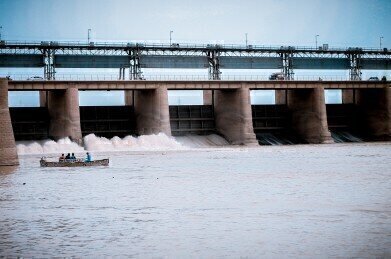Water/Wastewater
Why Did Los Angeles Fill a Reservoir with 96 Million Balls?
Sep 16 2015
As California’s four-year drought rumbles on, officials within LA have attempted to safeguard a precious water supply in a large reservoir by emptying 96 million ‘shade balls’ onto the surface of the water.
The project, which cost the city of Los Angeles a total of $34.5 million (around £22.5 million), had been ongoing for months and only came to completion in the middle of August, when the remaining 20,000 balls were released onto the surface of the reservoir.
A Strategy with Threefold Gains
The thinking behind the unusual initiative was dreamt up by a retired biologist, who noticed the effect of ‘bird balls’ in pools of water alongside airport runways. The black-coloured balls work by obscuring sunlight from the water, which is essential in preventing harmful chemical reactions and avoiding evaporation.
The technique could save the city as much as 300 million gallons (around 1.4 billion litres) in water which would have otherwise evaporated. That’s enough H20 to provide drinking water for a whole year for more than 8,000 residents of California – a considerable amount.
Furthermore, it also serves to prevent the sun’s rays reacting with the chlorine pumped into the water to disinfect it and the bromide which is a naturally-occurring element in the Earth itself. When exposed to UV radiation, these two elements can form a cancer-causing property known as bromate. Therefore, the ‘shade balls’ do the job suggested by their title and prevent the carcinogen from being produced.
Finally, the 96 million balls will act as a deterrent from any neighbouring wildlife contaminating the water through consuming it, defecating in it or dying in it.
Fighting an Uphill Battle
With each individual ball costing $0.36 (approximately £0.23), the total outlay on the venture is a whopping $34.5 million. That might sound like a lot – but the expense saved in water which would be lost to evaporation, dispensing with the necessity of chemical treatment to eradicate algae or other pollutants and that which might be incurred through wildlife interference could run as high as a quarter of a billion dollars (£162 million, roughly).
Of course, the drastic measure is being used to deal with drastic times. California is facing one of the severest droughts on record and as the most populous state in the US, it clearly faces an uphill battle to keep all of its residents hydrated and in command of enough water.
The shade ball plan is just one of several measures being taken to try and maximise the state’s dwindling water resources. Elsewhere, the city of Salinas installed the first-of-its-kind hexavalent chromium treatment system, capable of converting groundwater into cleaning, drinking water. The ion exchange technology is both innovative and vital if California is to overcome this seemingly never-ending drought.
Events
Apr 22 2024 Hannover, Germany
Apr 23 2024 Kuala Lumpur, Malaysia
Apr 24 2024 Sao Paulo, Brasil
May 05 2024 Seville, Spain
May 13 2024 Munich, Germany













